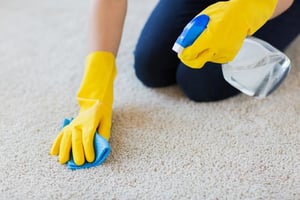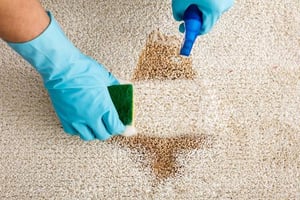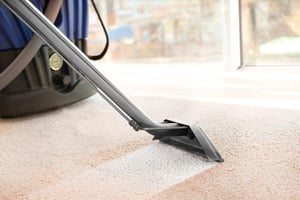Commercial carpets can be easy to maintain on a weekly basis, but stains and deep cleanings can often present a challenge. You want to address any spills and stains quickly in order to preserve the carpet’s lifespan.
But how can you treat carpet stains in commercial settings quickly and effectively without impacting the quality of the carpet or the workspace?
At Floorcare, we focus on eco-friendly products that do good for your floors and your health. So we set out on a mission to find out how to easily lift your commercial carpet stains without exposing your workers or floors to harsh chemicals.
So what should you do if you have a spill or stain on your commercial carpets?
1. React quickly.
If the spill is recent, react swiftly before the liquid cools or dries. Blot up any surface liquid with white paper towels or rags. Try to absorb as much excess liquid as you can by applying firm pressure. Blot the stain and lift upwards. Do not rub. This is especially important for hot liquids like coffee, which settle deeply into carpet fibers once they cool.
The faster you react, the less likely the stain will set and cause permanent distortion or loss of color on the carpet.
2. Lift solids.
You’ll want to first get rid of any solids on the stain, like food or gum. Apply an ice cube (or multiple) on the solids. This will help dry out the food or gum so it can crack away from the carpet.
Using a spoon or scraper, gently lift the food away from the carpet. Try to lift as much as you can without pulling the fibers of the carpet. If it doesn’t crack off easily, leave the ice on longer.
For glue, dip a cotton ball or rag in rubbing alcohol and press on the glued area. The glue will moisten, making it easier to pull off. Repeat until you have pulled off the excess glue.
For cigarette burns, gently rub the stain with the back of a dull knife or scraper. This will gently remove the ashes. This should remove the mark, but you may want to repeat the below steps to further rid any debris or gunk.

3. Rinse.
For most stains, you’ll want to rinse with cold water before applying any solvent. We recommend spraying the water directly on the stain and then blotting up with a paper towel. This helps pick up any extra moisture left from the spill. If working with an old stain, this will help re-wet the stain so it’s more workable. Don’t pour too much water—a light spritz will do.
In some cases, with dark stains like coffee or red wine, you might want to soak the fresh stain in soda water. The carbonation in the soda helps interact with stain particles to lift them away.
Blotting tips:
- Always use white paper towels or rags. This ensures no color is transferred from the towel to the carpet.
- Use fresh towels and rags with each rinse.
- Always blot or dab moving from the outside towards the middle. Apply pressure, and lift straight up. This helps avoid spreading of the stain or spill.
- Never scrub the carpet. Scrubbing will damage the carpet fibers and turn them “fuzzy.”
4. Apply a solvent.
After rinsing, you’ll want to apply a stain-fighting solvent. Our favorite eco-friendly, homemade solvent recipe is:
- 1 liter water
- 1 teaspoon wool-friendly laundry detergent
- 1 teaspoon white vinegar
We recommend making and storing a large batch of this solvent to use throughout the week or month. This gives your crew quick access to a natural stain solvent if they notice a stain on the floor. Be sure to store the solvent safely.
Some stains require specialty solvents. For example, blood lifts best with a mixture of 1 tablespoon ammonia and one cup of water. The ammonia will chemically react with the blood to lift the stain.
Let the solvent sit for 5 to 10 minutes.

5. Rinse again.
After applying the solvent, rinse again with warm water. This removes any leftover vinegar, detergent, or ammonia to avoid damaging the floor in the long-term.
6. Apply a spot cleaner.
After rinsing, you may need to apply a spot solution. This will help attack stains on a deeper, more concentrated level.
We recommend a non-toxic, pH neutral spot cleaner. Try Godfrey Hirst Spot Out ™ Carpet Stain Remover.
7. Rinse a third time.
After letting the cleaner sit and work its magic, you’ll want to rinse again with warm water to remove any leftover chemicals or stain particles.
Dry with a paper towel, blotting and applying pressure. You can also lay a white paper towel on top of the stain and place a flat weight on top. This will help pull up any leftover moisture—and stains along with it.
8. Repeat until gone.
If there are still some remnants of a stain or if the stain returns, go through the process again from steps 3 to 7. Two or three rounds of stain-fighting should completely remove the stain.
If the stain is still present, you may want to hire a professional carpet cleaner. If you have carpet tiles, you can also consider replacing the stained tile.
9. Dry carpet.
Moisture in carpets can breed bacteria, mold, and mildew. Make sure you thoroughly dry the carpet to avoid any moisture damage. Don’t walk on the carpet until dry.
We don’t recommend using a hair dryer or heater, as this can damage the carpet and release odors from wool fibers. Use a cool ventilation fan to help dry the area without heat.

10. Consider a wet/dry vacuum.
For large spills, you may want to use a wet/dry vacuum. This will wet the carpet and lift the stain with electric suction. For deep or large stains, this is usually a more effective method.
Bonus Tips
- Use protective floor mats to absorb excess liquid and dirt from the outside. Most stains are trekked in from the outside.
- Put “spot checks” on your crew’s daily list of to-dos. This can help spot stains before they set in too deeply.
- Make sure all workers in the commercial space know who to call the moment a spill happens. Make the janitorial team available and accessible. Reacting to spills quickly protects from long-term stains and damage.
- Deep clean your carpets often. We recommend steam cleanings at least twice per year. This uses hot water extraction to suck up any dirt and debris while flushing out stains and spills. Keep in mind that large volumes of water will breed bacteria, so you’ll need a strong ventilation system to dry floors after a steam cleaning. Other methods of deep cleaning include shampooing, dry chemical, encapsulation, pad or bonnet, and absorbent cleaning.
- Be aware of wool carpets. Untreated wool releases a pungent odor when wet. Avoid letting spills or moisture sit for too long on wool carpet surfaces.
The Bottom Line
Reacting to spills quickly and efficiently protects your floors from permanent damage and stains. But stains don’t have to be the enemy. With an eco-friendly solvent and a little elbow grease, your team can efficiently remove stains to get commercial floors looking fresh and new.
Looking to remove commercial carpet stains but don’t know where to begin?
Contact Floorcare for FREE personalized help and advice!




0 comments